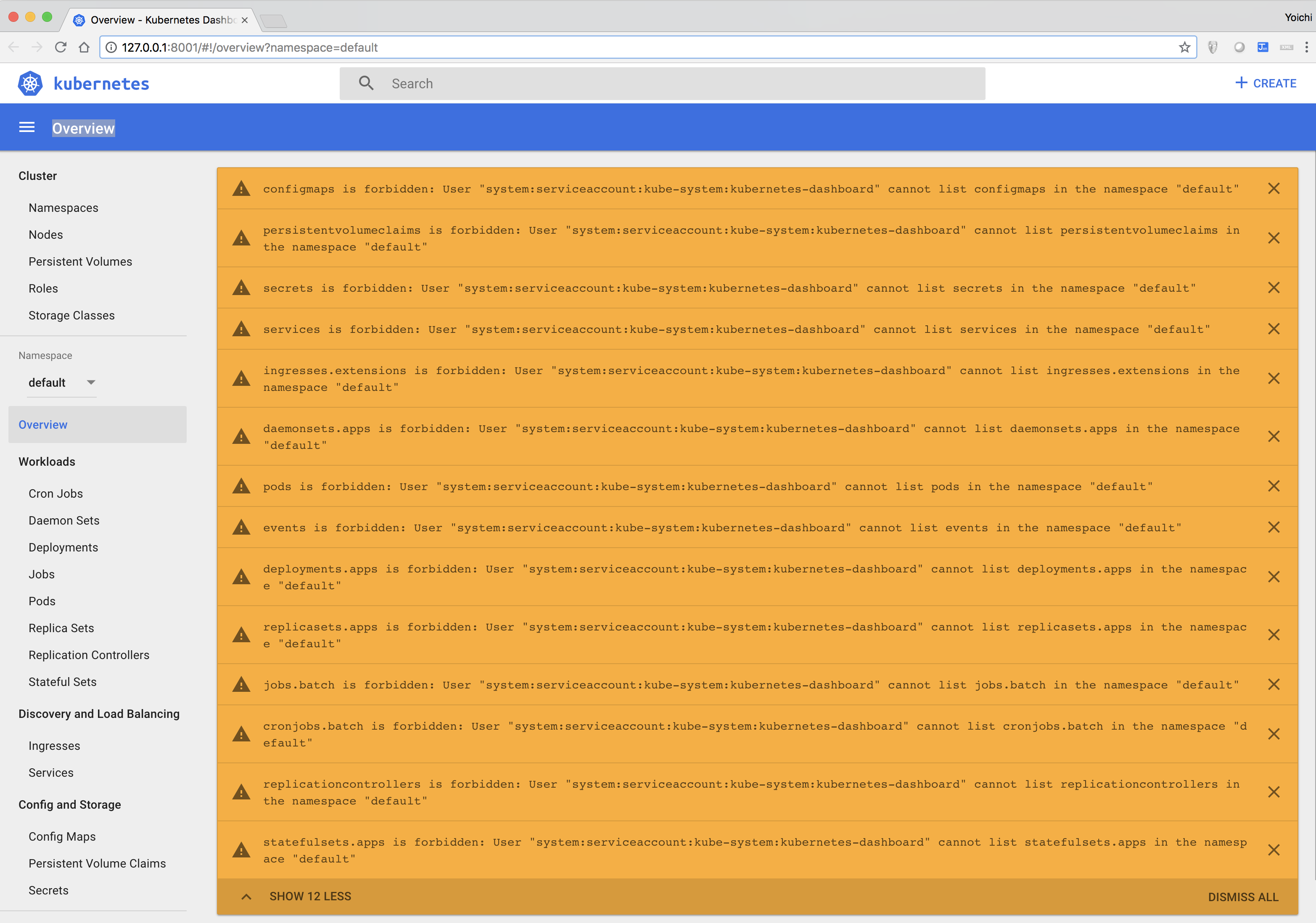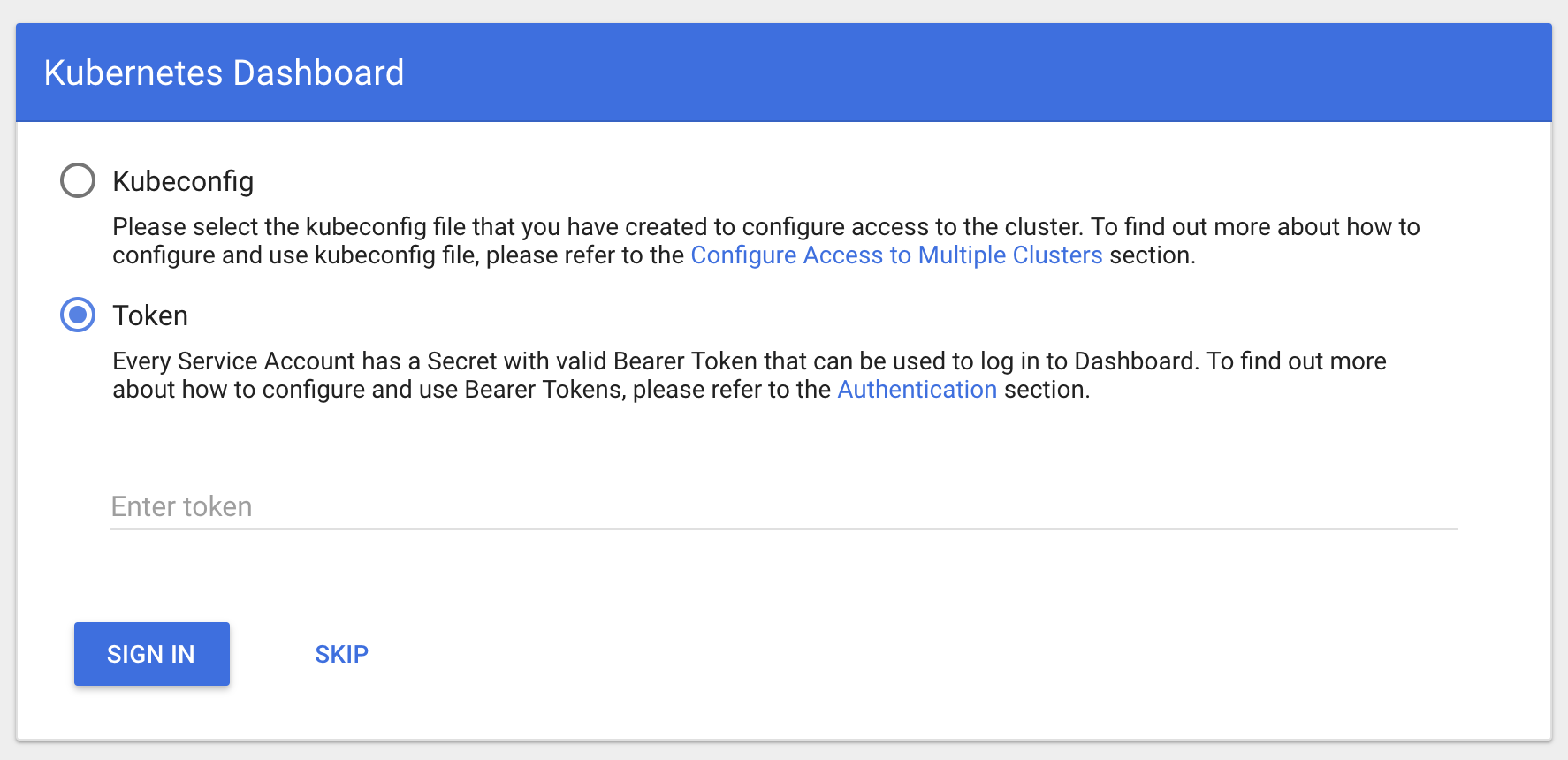This is an article on how you can configure Service Account and RoleBinding in order to make Dashbaord work. As of release Kubernetes v1.7, Dashboard no longer has full admin privileges granted by default. All the privileges are revoked and only minimal privileges granted, that are required to make Dashboard work. With default priviledge, you’ll see the following errors showed up on the Dashboard.

[Azure Kubernetes Service (AKS)] RBAC is enabled by default
Since Azure CLI version 2.0.40, RBAC is enabled by default. As you can see in the Azure command help, your cluster is RBAC enabled unless you specify --disable-rbac during the creation of the cluster.
$ az --version
azure-cli (2.0.43)
$ az aks create --help
--disable-rbac : Disable Kubernetes Role-Based Access Control.
--enable-rbac -r [Deprecated] : Enable Kubernetes Role-Based Access Control. Default:
enabled.
Argument 'enable_rbac' has been deprecated and will be removed in a future release. Use
'--disable-rbac' instead.
Option 1: Access to Dashboard with your Service Account
In option 1, I introduce how to give priviledge your Service Account and access to the Dashboard with the account. Actually there are a couple of authorization options, and here I introduce how to authorize with Bear Token
[NOTE] According to this,
As of release 1.7 Dashboard supports user authentication based on:
- Authorization: Bearer header passed in every request to Dashboard. Supported from release 1.6. Has the highest priority. If present, login view will not be shown.
- Bearer Token that can be used on Dashboard login view.
- Username/password that can be used on Dashboard login view (Disabled by default)
- Kubeconfig file that can be used on Dashboard login view
1-1. Create your Service Account for Dashboard access
First of all, create your Service Account my-admin-user like this:
$ kubectl create serviceaccount my-admin-user -n kube-system
Or you can create the Service Account with the following YAML my-sa.yaml and deploying it with kubectl create -f my-sa.yaml:
# my-sa.yaml
apiVersion: v1
kind: ServiceAccount
metadata:
name: my-admin-user
namespace: kube-system
Check if your Service Account (my-admin-user) has been added.
$ kubectl get sa -n kube-system
NAME SECRETS AGE
addon-http-application-routing-external-dns 1 9d
addon-http-application-routing-nginx-ingress-serviceaccount 1 9d
attachdetach-controller 1 9d
certificate-controller 1 9d
clusterrole-aggregation-controller 1 9d
cronjob-controller 1 9d
daemon-set-controller 1 9d
default 1 9d
deployment-controller 1 9d
disruption-controller 1 9d
endpoint-controller 1 9d
generic-garbage-collector 1 9d
heapster 1 9d
horizontal-pod-autoscaler 1 9d
job-controller 1 9d
kube-dns 1 9d
kube-proxy 1 9d
kube-svc-redirector 1 9d
kubernetes-dashboard 1 9d
my-admin-user 1 15s
namespace-controller 1 9d
node-controller 1 9d
persistent-volume-binder 1 9d
pod-garbage-collector 1 9d
pv-protection-controller 1 9d
pvc-protection-controller 1 9d
replicaset-controller 1 9d
replication-controller 1 9d
resourcequota-controller 1 9d
route-controller 1 9d
service-account-controller 1 9d
service-controller 1 9d
statefulset-controller 1 9d
ttl-controller 1 9d
tunnelfront 1 9d
1-2. Binding the role cluster-admin to the Service Account
Create a ClusterRoleBinding which gives the role cluster-admin (= full admin priviledge) to the ServiceAccount my-admin-user
$ kubectl create clusterrolebinding my-admin-user -n kube-system --clusterrole=cluster-admin --serviceaccount=kube-system:my-admin-user
Or you can grant the priviledges with the following YAML my-sa-binding.yaml and deploying it with kubectl create -f my-sa-binding.yaml:
# my-sa-binding.yaml
apiVersion: rbac.authorization.k8s.io/v1beta1
kind: ClusterRoleBinding
metadata:
name: my-admin-user
roleRef:
apiGroup: rbac.authorization.k8s.io
kind: ClusterRole
name: cluster-admin
subjects:
- kind: ServiceAccount
name: my-admin-user
namespace: kube-system
1-3. Authentication Option - Give Bear Token at Dashboard login view
1-3-1. Get the Token of the ServiceAccount
$ kubectl get secret $(kubectl get serviceaccount my-admin-user -n kube-system -o jsonpath="{.secrets[0].name}") -o jsonpath="{.data.token}" -n kube-system | base64 --decode
Or you can obtain the token step by step like this:
# Get secret name for my-admin-user
$ kubectl get serviceaccount my-admin-user -n kube-system -o yaml
apiVersion: v1
kind: ServiceAccount
metadata:
creationTimestamp: 2018-08-11T06:53:34Z
name: my-admin-user
namespace: kube-system
resourceVersion: "1075968"
selfLink: /api/v1/namespaces/kube-system/serviceaccounts/my-admin-user
uid: 44142169-9d33-11e8-b7d0-de454880a5dc
secrets:
- name: my-admin-user-token-nzp4f
# Get secret string and base64 decoded it
$ kubectl get secret my-admin-user-token-nzp4f -n kube-system -o jsonpath="{.data.token}" | base64 --decode
eyJhbGciOiJSUzI1NiIsImtpZCI6IiJ9.eyJpc3MiOiJrdWJlcm5ldGVzL3NlcnZpY2VhY2NvdW50Iiwia3ViZXJuZXRlcy5pby9zZXJ2aWNlYWNjb3VudC9uYW1lc3BhY2UiOiJrdWJlLXN5c3RlbSIsImt1YmVybmV0ZXMuaW8vc2VydmljZWFjY291bnQvc2VjcmV0Lm5hbWUiOiJteS1hZG1pbi11c2VyLXRva2VuLW56cDRmIiwia3ViZXJuZXRlcy5pby9zZXJ2aWNlYWNjb3VudC9zZXJ2aWNlLWFjY291bnQubmFtZSI6Im15LWFkbWluLXVzZXIiLCJrdWJlcm5ldGVzLmlvL3NlcnZpY2VhY2NvdW50L3NlcnZpY2UtYWNjb3VudC51aWQiOiI0NDE0MjE2OS05ZDMzLTExZTgtYjdkMC1kZTQ1NDg4MGE1ZGMiLCJzdWIiOiJzeXN0ZW06c2VydmljZWFjY291bnQ6a3ViZS1zeXN0ZW06bXktYWRtaW4tdXNlciJ9.2ulwCWd7MOnQjoecAY2NoleIxcHD8tda97ud3cK-kHWmdCodAejvddA4YjYozzBu2bWNA83aVTvKAn5-Uv1DC47U5FPh2LXAXNPXn4PyrdLO7TFZdHYmkvUgJKsg25vJvJmsWF9eQOinjjh_g16aGgdxrWz0NGJz5d1eE5GDP5NXXTTgxXlD_GFQduhlq8kc89dhpDUXMYe60-KzZvNaQhIskPsnxHMix1JrHEdtfciFhHRb2CBNjPWfcg455NGoS9S-k0qTfoIHYJC627p75E8TGqyTIa8TSg8vaif4XWgeg_OZWqEIGHTIrhEAGO4ElFijdZuzAg2-v9BGWe8i4q1i70ca5CwReJTG8t13eeOoEkq--VbhDAMY6rxmx-hi9dwf-zjsD233MdHJLh1yRi0eo_k5ov7fwDDsLQXeCTBIjSAzorvXseWr5m9sQ7yREbjDXCOsHbYo5xNV5ii-yOlxYyiqPxZZnnSwzllj1lwPDLSL0MyxkR9siF52vbkNDe6qdYYMqPtA-jTMIw_iLlB-WeN1Fx8423c4x5wV6IGPJZFuOYZhB0ra4jfRSS39vesaNodW8RjHUiuOSVA8_j-DxwOxa8prynALFWGswSMy6PfVQydouU6vammeqPBel9-IqBeTXY-57YumELG1PdcOcxdrBCZUlxBvJWbItxA
1-3-2. Give Bear Token at Dashboard login view
Now that you have a bear token that you need to grant the full priviledges to your Service Account, let’s access to the Dashboard login view.
First of all, create a proxy to the dashboard:
$ kubectl proxy
Starting to serve on 127.0.0.1:8001
Then, access to the Dashboard login page:
$ open http://localhost:8001/api/v1/namespaces/kube-system/services/kubernetes-dashboard/proxy/#!/login
Or if it’s on Azure, you can leverage Azure CLI command to access the Dashboard like this:
$ az aks browse --resource-group <RESOURCE_GROUP> --name <CLUSTER_NAME>
$ open http://127.0.0.1:8001/#!/login
You will see the following Dashboard login view. Choose Token option and enter the bear token you got above. You will be able to access and operate with the Dashboard without any errors.

Easy login by giving Authorization header using Browser extention
As introduced in here, install Requestly browser plugin and configure to make Dashboard use authorization header. You simply need to configure the plugin to pass the following header in accessing the dashboard:
Authorization: Bearer <token>
HERE is the example screen shot:

Option2: Granting admin privileges to Dashboard’s Service Account
In Option 2, I introduce how to give full privilege (role: cluster-admin) to the Dashboard’s Service Account kubernetes-dashboard. With this option, you can skip the authorization process that you do in the option 1 to access Dashboard. However, as mentioned here, granting admin privileges to Dashboard’s Service Account might be a security risk.
First of all, create a ClusterRoleBinding which gives the role cluster-admin (= full admin priviledge) to the ServiceAccount kubernetes-dashboard
$ kubectl create clusterrolebinding kubernetes-dashboard -n kube-system --clusterrole=cluster-admin --serviceaccount=kube-system:kubernetes-dashboard
Or you can do the same with the following YAML dashboard-sa-binding.yaml and deploying it with kubectl create -f dashboard-sa-binding.yaml:
# dashboard-sa-binding.yaml
apiVersion: rbac.authorization.k8s.io/v1beta1
kind: ClusterRoleBinding
metadata:
name: kubernetes-dashboard
labels:
k8s-app: kubernetes-dashboard
roleRef:
apiGroup: rbac.authorization.k8s.io
kind: ClusterRole
name: cluster-admin
subjects:
- kind: ServiceAccount
name: kubernetes-dashboard
namespace: kube-system
Finally, access to the Dashboard. You’ll be able to access and operate without any errors.